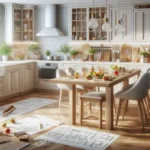The kitchen is often considered the heart of the home, a gathering place where culinary adventures unfold and memories are made.
At the center of this vibrant space, a stylish and functional kitchen island can serve as the ultimate multifunctional hub, blending practicality with aesthetic appeal. Whether you’re a passionate home chef looking to elevate your cooking experience, a busy parent needing extra prep space, or an entertainer seeking a chic setting for social gatherings, a well-designed kitchen island can transform your cooking area into a dynamic environment. In this blog post, we’ll explore innovative ideas and practical tips on how to create a kitchen island that not only enhances the style of your space but also maximizes its functionality, ensuring that it becomes the go-to spot for both everyday meals and special occasions. Get ready to reimagine your kitchen and discover how the perfect island can redefine your culinary experience!
1. Introduction: The Benefits of a Kitchen Island
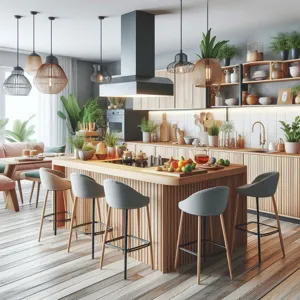
A kitchen island is more than just a functional addition to your cooking space; it is the heart of your kitchen and can dramatically transform the way you interact with this essential area of your home. Imagine a versatile surface where culinary creativity flourishes, where family and friends gather for casual meals, and where kids can complete their homework while you prepare dinner. The benefits of incorporating a kitchen island extend beyond mere aesthetics, offering a blend of style, functionality, and social connection.
One of the primary advantages of a kitchen island is the additional workspace it provides. Whether you are chopping vegetables, rolling out dough, or assembling elaborate meals, having that extra counter space can make cooking a more enjoyable and efficient process. Furthermore, many kitchen islands come equipped with storage solutions, such as cabinets and drawers, allowing you to keep your kitchen organized and clutter-free. This added functionality ensures that essential tools and ingredients are within arm’s reach, making meal preparation a breeze.
In addition to practicality, a well-designed kitchen island can serve as a stunning focal point in your kitchen. With an array of materials, colors, and styles to choose from, it can reflect your personal taste and complement the overall design of your home. Whether you opt for a sleek, modern look with a quartz countertop or a rustic farmhouse style with reclaimed wood, the right kitchen island can elevate your space and create an inviting atmosphere.
Moreover, a kitchen island fosters social interaction, making it an ideal spot for entertaining guests. Picture hosting a dinner party where conversations flow effortlessly as your friends gather around the island, enjoying appetizers and drinks while you finish preparing the main course. This communal space encourages connection and makes your kitchen the go-to hub for gatherings.
In summary, the benefits of a kitchen island are vast and varied, enhancing both the functionality and aesthetics of your home. As we delve deeper into this guide, we will explore the essential elements to consider when designing your dream kitchen island, ensuring it becomes a beloved feature of your culinary space for years to come.
2. Assessing Your Space: Measuring and Planning
Creating a stylish and functional kitchen island begins with a crucial step: assessing your space. This phase is all about measurement and thoughtful planning, ensuring your new island not only enhances your kitchen’s aesthetic but also fits seamlessly into your existing layout.
Start by taking precise measurements of your kitchen, noting the dimensions of the room, the location of windows, doorways, and any existing fixtures such as cabinets and appliances. A well-planned island should complement your kitchen’s flow, so consider how different areas are utilized. For instance, if you often entertain guests, a larger island with seating options can encourage social interaction. If your kitchen is compact, a smaller, multifunctional island that doubles as a prep area might be more suitable.
When measuring, allow for ample walking space around the island. A general rule of thumb is to maintain a clearance of at least 36 to 48 inches on all sides to ensure easy movement, especially when multiple people are in the kitchen. Visualize your design by using painter’s tape to outline the island’s dimensions on the floor. This will give you a palpable sense of how the island will fit within the overall space and help you gauge sightlines and accessibility.
Additionally, think about the functionality you desire from your island. Will it serve as a cooking station, a breakfast bar, or a homework hub? Planning for electric outlets, storage solutions, and even built-in appliances will elevate your island’s utility. By carefully measuring and planning, you can ensure your kitchen island not only looks stunning but also enhances the overall functionality of your kitchen, making it the heart of your home.
3. Choosing the Right Style: Modern, Rustic, or Traditional?
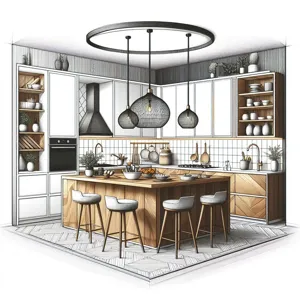
Selecting the right style for your kitchen island is crucial, as it sets the tone for the entire space and reflects your personal aesthetic. With three popular styles to consider—modern, rustic, and traditional—understanding the nuances of each can help you make a choice that harmonizes with the existing décor of your kitchen while also fulfilling your functional needs.
**Modern Style:** If you lean towards sleek lines and minimalist design, a modern kitchen island is your go-to. Characterized by clean, geometric shapes and a neutral color palette, modern islands often feature materials like stainless steel, quartz, or glass. These islands are not just visually appealing but also highly functional, often integrating smart technology, ample storage, and even built-in appliances. Imagine a spacious island with a waterfall countertop, seamlessly blending beauty and functionality, perfect for a contemporary kitchen where style and efficiency reign supreme.
**Rustic Style:** For those who favor warmth and charm, a rustic kitchen island can evoke a sense of coziness and nostalgia. Typically crafted from reclaimed wood or distressed finishes, these islands often showcase natural textures and earthy tones that bring the outdoors inside. Think of a large farmhouse table-style island adorned with vintage-inspired accessories—perhaps a butcher block surface for food prep, open shelving for displaying cookbooks, and mason jar decor that adds a personal touch. A rustic island not only serves practical purposes but also becomes the heart of the home, inviting family and friends to gather and share meals.
**Traditional Style:** If you appreciate classic elegance, a traditional kitchen island might be the perfect fit. This style often features ornate details, intricate moldings, and rich wood tones that exude sophistication. Traditional islands may include additional elements like decorative legs, raised panels, and even an antique finish that tells a story of timeless craftsmanship. These islands serve as a beautiful focal point, often complementing cabinetry and fixtures to create a cohesive and inviting space. With the right design, a traditional island can enhance the overall warmth of your kitchen while providing essential functionality for cooking and entertaining.
Ultimately, the style you choose should reflect your personality and lifestyle. Whether you opt for the sleek lines of modernity, the warmth of rustic charm, or the timeless elegance of tradition, your kitchen island can be a stylish and functional centerpiece that transforms your culinary space into a haven of creativity and comfort.
4. Material Matters: Selecting Countertops and Cabinetry
When it comes to creating a stylish and functional kitchen island, the choice of materials for countertops and cabinetry can make all the difference. Not only do they define the aesthetic of your space, but they also play a crucial role in the durability and functionality of your kitchen.
**Countertops** are one of the most prominent features of an island, acting as both a workspace and a visual focal point. Consider materials that suit your lifestyle and cooking habits. For a sleek, modern look, quartz and marble are popular choices, each offering a unique blend of beauty and resilience. Quartz is non-porous and low-maintenance, making it ideal for busy kitchens. Marble, on the other hand, boasts a timeless elegance, though it requires more care to maintain its pristine appearance.
If you’re seeking a rustic charm, butcher block countertops can provide warmth and a touch of homey appeal. They are perfect for those who love to cook, as they are gentle on knives and can be refinished when they show wear. For a more industrial vibe, consider concrete countertops, which offer a unique, customizable look that can be both stylish and incredibly durable.
**Cabinetry**, too, plays a pivotal role in the overall design of your kitchen island. Choose cabinetry that complements your countertops and aligns with your design vision. Shaker-style cabinets offer a classic and versatile look, while sleek, flat-panel cabinets can enhance a contemporary aesthetic. Material choices range from solid wood to high-quality laminate, each offering distinct advantages. Solid wood provides durability and a rich, authentic feel, while laminate can offer a more budget-friendly and low-maintenance option.
Beyond aesthetics, consider the functionality of your cabinetry. Incorporate features like pull-out shelves, deep drawers for pots and pans, or open shelving to display your favorite cookbooks and decorative items. Thoughtfully designed cabinetry not only enhances the visual appeal of your kitchen island but also makes cooking and entertaining more efficient and enjoyable.
In conclusion, when selecting materials for your kitchen island, prioritize both style and practicality. By choosing the right countertops and cabinetry, you can create a stunning centerpiece that elevates your kitchen’s design while ensuring it meets your everyday needs.
5. Functional Features: Incorporating Storage Solutions
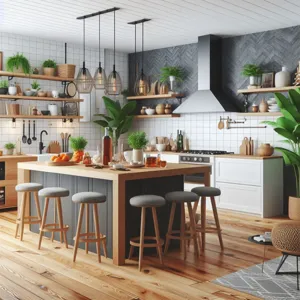
When it comes to designing a kitchen island that is both stylish and functional, incorporating smart storage solutions is essential. A well-thought-out island can serve as the heart of your kitchen, offering not only additional workspace but also a clever way to maximize storage in an often-limited area.
Begin by considering the layout of your kitchen and the specific items you need to store. Deep drawers for pots and pans are a must; they keep everything organized and easily accessible while eliminating the hassle of rummaging through cluttered cabinets. Pull-out shelves can be a game changer, allowing you to effortlessly reach the items at the back without awkwardly bending over.
If you’re short on space, think vertically. Open shelving above the island can display your favorite cookbooks, stylish dishes, or even decorative items. This not only adds a personal touch but also encourages organization and easy access. For those looking to keep the countertop clear, a concealed trash bin integrated into the island is a practical solution, ensuring waste is out of sight yet still within reach.
Consider adding a wine rack or cubby for cookbooks, which not only looks chic but also reflects your culinary interests while keeping everything within arm’s reach. If you’re a baking enthusiast, designing a dedicated section for baking sheets and mixing bowls could elevate your cooking game, making it easier to pivot from prep to bake.
Lastly, don’t forget about electrical storage. Including outlets in your island design allows for convenient access to power, whether you need to plug in a mixer or charge your devices.
By thoughtfully incorporating these functional features into your kitchen island, you can create a space that is not only aesthetically pleasing but also enhances your cooking experience, making your kitchen the ultimate gathering spot for family and friends.
6. Seating Arrangements: Bar Stools vs. Dining Chairs
When designing your kitchen island, the choice of seating can significantly influence both its functionality and aesthetic appeal. Two popular options are bar stools and dining chairs, each bringing distinct characteristics to your space.
**Bar Stools:** If you envision a casual, lively atmosphere, bar stools might be your best bet. Their height naturally complements the elevated surfaces of most kitchen islands, allowing for a comfortable perch that encourages social interaction. Available in a variety of styles, materials, and colors, bar stools can become a focal point in your kitchen. Opt for sleek, modern designs in metal or wood for a contemporary look, or choose upholstered stools for a touch of warmth and comfort. Additionally, consider stools with adjustable height features or swivel capabilities for added versatility, making it easy for family and friends to gather around during meal prep or casual snacking.
**Dining Chairs:** On the other hand, if you prefer a more formal or traditional dining experience, dining chairs could be the perfect addition to your kitchen island. Their wider bases and lower heights can create a seamless transition between your kitchen and dining areas, providing comfortable seating for longer meals or family gatherings. Dining chairs offer the opportunity to mix and match styles, allowing for a more personalized and eclectic look. You can choose from a variety of materials, from rustic wooden chairs to sleek upholstered designs, ensuring that your seating complements the overall decor of your kitchen.
Ultimately, the decision between bar stools and dining chairs comes down to your lifestyle and design preferences. Think about how you plan to use your kitchen island: is it a space for quick breakfasts, or a gathering spot for family dinners? By carefully considering your seating arrangements, you can create a kitchen island that is not only stylish but also functional, elevating the heart of your home to new heights.
7. Lighting Design: Enhancing Your Kitchen Island with Illumination
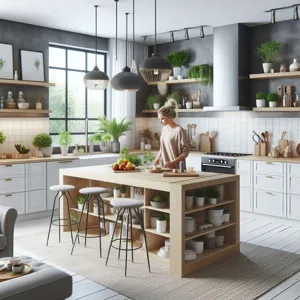
Lighting design plays a crucial role in elevating the aesthetic and functional aspects of your kitchen island. A well-lit island not only enhances the overall ambiance of the kitchen but also serves practical purposes, making meal prep, cooking, and socializing more enjoyable.
To start, consider layering your lighting. A combination of ambient, task, and accent lighting can create a warm and inviting atmosphere while ensuring that the island is adequately illuminated for various activities. Pendant lights are a popular choice, hanging gracefully above the island to provide focused light right where you need it. Choose fixtures that reflect your style—whether sleek and modern or rustic and vintage—to add personality to your space.
In addition to pendant lights, under-cabinet lighting can be a game-changer. This soft glow not only brightens the countertop but also highlights any beautiful materials or textures you’ve chosen for your island, such as a stunning marble or rich wood finish. LED strip lights are an excellent option for this; they are energy-efficient and can be easily installed to create a seamless look.
Don’t overlook the importance of dimmers. Installing dimmable switches allows you to control the intensity of the light, adapting the mood of your kitchen island for different occasions, from lively gatherings with friends to quiet family dinners.
Lastly, consider the color temperature of your lighting. Warmer tones create a cozy environment, perfect for family gatherings, while cooler tones can lend a more contemporary feel, ideal for cooking and meal prep. By thoughtfully designing the lighting around your kitchen island, you not only enhance functionality but also create a space that invites connection and creativity, making your kitchen the heart of your home.
8. Color Schemes: Harmonizing with Your Kitchen Aesthetic
When it comes to designing the perfect kitchen island, the color scheme you choose plays a pivotal role in harmonizing the island with your overall kitchen aesthetic. This is not just about picking a color that looks good; it’s about creating a cohesive visual flow that enhances the beauty and functionality of your space.
Start by considering the existing colors in your kitchen. If you have a neutral palette featuring whites, grays, or beiges, you might want to incorporate a bold accent color for your island to create a striking focal point. Deep navy or a rich, earthy green can add depth and sophistication, transforming your island into a statement piece. Alternatively, if your kitchen already boasts vibrant hues, opt for a complementary or analogous shade to maintain visual harmony without overwhelming the senses.
Textures also play a crucial role in your color scheme. Pairing a smooth, glossy finish with a matte or textured surface can add dimension and intrigue. For instance, a sleek white marble countertop atop a warm wooden base can create a beautiful contrast that invites touch and interaction. Consider the materials of your cabinetry, countertops, and flooring as you choose colors; consistency across these elements will help tie the space together seamlessly.
Don’t forget the impact of lighting on your color choices. Natural light can shift the perception of colors throughout the day, while pendant lights or under-cabinet lighting can cast delightful warm tones or cooler shades. Test your color selections in various lighting conditions to ensure they evoke the desired mood and complement your kitchen’s overall design.
Lastly, remember that the kitchen is often the heart of the home, where family and friends gather. Choose colors that not only reflect your personal style but also create an inviting atmosphere. Soft pastels can evoke a sense of calm, while vibrant, energetic tones can inspire creativity and conversation. By thoughtfully harmonizing your kitchen island’s color scheme with your kitchen’s aesthetic, you’ll create a space that is both stylish and functional, welcoming all who enter.
9. Adding Personal Touches: Décor and Accessories
When it comes to creating a kitchen island that truly reflects your personality and lifestyle, adding personal touches through décor and accessories is key. This is the stage where functionality meets individuality, transforming your kitchen island from a mere workstation into a vibrant focal point that exudes warmth and style.
Start by selecting decorative items that resonate with your taste. Perhaps a collection of rustic wooden bowls filled with fresh fruits can introduce a pop of color and a touch of nature. Not only do they serve a practical purpose, but they also create a welcoming atmosphere. Consider displaying a few cookbooks that not only provide culinary inspiration but also showcase your love for cooking. Stacking them on the countertop or propping them up with a decorative stand can add an inviting touch.
Lighting is another essential element that can elevate the aesthetic of your kitchen island. Pendant lights hung above the island can create a dramatic effect, providing both illumination and style. Opt for fixtures that complement the overall theme of your kitchen—whether you prefer modern, industrial, or farmhouse styles, the right lighting can enhance the ambiance and make your island a gathering place for family and friends.
Incorporate personal accessories that tell your story. A stylish vase filled with fresh flowers can add a touch of elegance and vibrancy, while unique kitchen gadgets or artisanal serving trays can showcase your culinary passion. If you love to entertain, consider adding a chic wine rack or a selection of your favorite cookbooks, ensuring your island is not just functional but also a conversation starter.
Lastly, don’t forget about textiles! A couple of well-placed placemats or a soft runner can add warmth and comfort, inviting everyone to gather around. By thoughtfully selecting décor and accessories, you can create an island that is not only stylish but also a true reflection of who you are, making your kitchen the heart of your home.
10. Maximizing Utility: Integrating Appliances and Sinks
When it comes to creating a stylish and functional kitchen island, maximizing utility is key—especially when considering the integration of appliances and sinks. An island isn’t just a beautiful centerpiece; it can also serve as a powerhouse of functionality, streamlining your cooking and entertaining experiences.
Start by envisioning your island as a multi-functional workspace. If space allows, incorporate a cooktop or a built-in stovetop that transforms your island into the heart of culinary activity. This allows you to engage with family and guests while preparing meals, making your kitchen a more sociable environment. Pair this with a ventilation hood overhead to maintain air quality and keep your cooking area pleasant.
Next, consider integrating a sink into your island design. A wet bar or prep sink can be a game-changer for meal prep and cleanup. This addition not only enhances convenience but also keeps the workflow efficient—allowing you to rinse vegetables or wash hands without having to traverse back and forth to the main sink. Select a stylish faucet that complements your overall kitchen aesthetic, adding a touch of elegance while enhancing functionality.
For those looking to elevate their kitchen island further, think about incorporating under-counter appliances, such as a wine fridge or a microwave. These hidden gems can free up counter space and offer easy access to beverages and snacks for entertaining without cluttering the surface.
Lastly, ensure that your island has ample storage solutions. Open shelving can add style and accessibility, while drawers and cabinets can keep utensils, pots, and pans neatly tucked away. Organizing your kitchen tools within reach keeps your workspace tidy and efficient.
By thoughtfully integrating appliances and sinks into your kitchen island design, you’ll create a space that not only looks incredible but also works hard for you, transforming your kitchen into a hub of style and functionality that you’ll love for years to come.
11. DIY vs. Professional Installation: Making the Right Choice
When it comes to installing a kitchen island, one of the most pivotal decisions you’ll face is whether to undertake the project yourself or hire a professional. Both options come with their own set of advantages and challenges, and making the right choice depends on various factors, including your skill level, budget, and the complexity of the installation.
**DIY Installation: The Hands-On Approach**
For those who relish a challenge and have a knack for home improvement, a DIY installation can be a rewarding endeavor. It allows you to personalize every aspect of your kitchen island, from the materials used to the final aesthetics. There are countless online resources, tutorials, and community forums that can guide you through the process, making it accessible even for novice DIYers. Additionally, tackling the project yourself can save you a significant amount of money, which can be redirected towards high-quality materials or enhancements. However, it’s crucial to be realistic about your skills and the time commitment involved. If you’re not well-versed in carpentry or plumbing, you might find yourself facing unexpected hurdles that could delay your project and lead to frustration.
**Professional Installation: Expertise at Your Service**
On the other hand, hiring a professional can streamline the process and ensure a polished finish. Experienced contractors bring a wealth of knowledge and skills, allowing them to navigate potential pitfalls and complexities with ease. They can also help with things like electrical work, plumbing, and ensuring that the island adheres to local building codes—elements that can be daunting for an inexperienced DIYer. While the initial cost may be higher, the peace of mind that comes from knowing the job will be done right can be well worth the investment. Plus, professionals often have access to better tools and resources, which can enhance the quality of the final product.
Ultimately, the decision between DIY and professional installation hinges on your confidence in your abilities and your willingness to invest time and energy into the project. Whichever route you choose, a well-planned kitchen island can transform your cooking space into a hub of style and functionality, making it the heart of your home.
12. Budgeting: Cost Considerations and Tips for Savings
When it comes to creating a stylish and functional kitchen island, budgeting is a crucial step that can make or break your project. The cost of a kitchen island can vary widely based on materials, size, and design complexity. To ensure you stay on track financially, it is essential to assess your budget early in the planning process.
Start by outlining your overall kitchen renovation budget, then determine how much of that you can allocate specifically for the island. Consider essential expenses such as materials, labor, and any additional features you wish to include, such as built-in appliances or seating. Custom islands, for instance, can significantly increase costs, while a DIY approach using ready-made components may offer substantial savings.
To maximize your budget, consider these tips for savings:
1. **Explore Multiple Options**: Visit local home improvement stores and browse online marketplaces for diverse materials and designs. Sometimes, off-the-shelf solutions can offer a more budget-friendly alternative to custom-built options without sacrificing style.
2. **Repurpose Materials**: If you’re feeling creative, think about incorporating reclaimed wood or salvaged materials. Not only does this add unique character to your island, but it can also be a cost-effective choice.
3. **Prioritize Functionality Over Aesthetics**: While aesthetics are important, ensure that functionality remains at the forefront of your design. Consider how you intend to use your island—whether for cooking, dining, or entertaining—and allocate your budget towards features that will enhance usability.
4. **Plan for the Future**: Think long-term when budgeting for your kitchen island. Investing in higher-quality materials may have a higher upfront cost but can lead to greater durability and less frequent need for replacement or repairs.
5. **Seek Professional Advice**: Consulting with a kitchen designer or contractor can provide insights into potential cost-saving measures. They can help you make informed decisions about what elements are worth splurging on and which can be scaled back.
By carefully considering these cost factors and tips, you can create a kitchen island that seamlessly blends style and functionality while remaining within your budget. Remember, a well-planned kitchen island can enhance both the aesthetics and the efficiency of your cooking space, making it a worthwhile investment in your home.
13. Maintenance Tips for Your Kitchen Island
Once you’ve invested time and creativity into crafting the perfect kitchen island, maintaining its beauty and functionality becomes essential. Regular upkeep not only extends the life of your island but also keeps it looking its best, ensuring it continues to be the heart of your kitchen for years to come. Here are some practical maintenance tips to keep your kitchen island in top shape.
**1. Regular Cleaning:** Start with the basics—keeping your island clean. Use a soft cloth and a gentle cleanser suitable for the surface material, whether it’s wood, granite, or quartz. For wooden islands, opt for a wood-safe cleaner and always wipe in the direction of the grain to prevent scratches. For stone surfaces, consider a pH-balanced cleaner to avoid damaging the finish.
**2. Sealing and Protecting:** If your kitchen island features wood, be sure to apply a quality sealant or finish regularly to protect it from moisture and spills. For stone surfaces, periodic resealing can help maintain their luster and prevent staining. Check the manufacturer’s recommendations for the best sealing schedules based on your material type.
**3. Avoid Heat Damage:** Be cautious with hot pots and pans directly on the surface. Always use trivets or hot pads to protect your island from heat damage, especially if it’s made of wood or has a delicate finish. A little prevention goes a long way in maintaining its appearance.
**4. Address Scratches Promptly:** Over time, your kitchen island may experience scratches or dents. For wooden surfaces, a simple touch-up with a wood marker or a bit of wax can work wonders. For stone surfaces, consult with a professional for more significant repairs to avoid further damage.
**5. Organize and Declutter:** A functional kitchen island does more than just look good; it serves as a workspace. Regularly organize items on your island, keeping only essentials and decorative pieces that enhance the overall aesthetic. A clutter-free surface not only looks appealing but also makes cleaning easier.
**6. Inspect for Wear and Tear:** Take the time to regularly inspect your kitchen island for any signs of wear, loose hardware, or structural issues. Addressing these concerns early can prevent more extensive repairs down the line, ensuring your kitchen island remains a stylish and functional centerpiece.
By incorporating these simple maintenance tips, you’ll not only preserve the beauty of your kitchen island but also enhance its functionality, making it a beloved gathering spot for family and friends for years to come.
14. Real-Life Examples: Inspiring Kitchen Island Transformations
When it comes to kitchen islands, inspiration can be found in an array of styles, designs, and functionalities that cater to various tastes and needs. Here, we delve into real-life examples of kitchen islands that have undergone stunning transformations, showcasing the creativity and innovation that can be achieved in this central hub of the home.
**The Rustic Charm Revival**
In a cozy farmhouse-style kitchen, a once-plain island was transformed into a stunning focal point with reclaimed wood and a live-edge countertop. The warm tones of the wood complemented the white cabinetry, while industrial-style pendant lights hung overhead, adding a touch of modernity. This island not only serves as a prep space but also features open shelving for displaying beautiful dishware and cookbooks, blending functionality with charm.
**Modern Minimalist Marvel**
In a sleek urban apartment, a kitchen island was reimagined as a minimalist masterpiece. Crafted from pure white quartz with clean lines, it features an integrated sink and a subtle overhang for casual dining. The island’s streamlined design enhances the open-concept layout, making it feel spacious and airy. The use of hidden storage beneath the island ensures that everything needed for meal prep is neatly tucked away, maintaining the aesthetic of simplicity.
**Multi-Functional Family Hub**
In a bustling family home, the kitchen island was transformed into a multi-functional hub to accommodate the needs of a busy lifestyle. This renovation included a built-in breakfast nook on one side with comfortable seating for casual meals and homework sessions. On the opposite side, a dual-level countertop allowed for designated prep space and dining, while cabinets and drawers provided ample storage for kitchen essentials, toys, and games. Bright, cheerful colors and playful decor made this island a beloved gathering spot for the whole family.
**Gourmet Chef’s Dream**
For the culinary enthusiast, a kitchen island can be a chef’s paradise. In one example, a homeowner transformed their kitchen island into a culinary workspace equipped with a professional-grade cooktop, a warming drawer, and a separate prep sink. The island’s surface was enhanced with a durable and heat-resistant material, perfect for baking and cooking adventures. With strategically placed lighting and a built-in spice rack, this kitchen island became a dream come true for anyone who loves to cook and entertain.
These real-life examples illustrate that a kitchen island can be much more than a simple countertop; it can be a stylish centerpiece that enhances both the aesthetic and functionality of your kitchen. Whether you lean towards rustic charm, modern minimalism, family-friendly designs, or gourmet culinary spaces, the possibilities are endless. Let these transformations inspire your own kitchen island project, and create a space that reflects your personal style while meeting your functional needs.
15. Conclusion: Enjoying Your Stylish and Functional Kitchen Space
In conclusion, creating a stylish and functional kitchen island is not just about aesthetics; it’s about enhancing the way you interact with your space. As the heart of the home, the kitchen deserves to be both beautiful and practical, serving as a gathering spot for family and friends while also elevating your cooking experience.
By thoughtfully considering your needs—from storage solutions to seating arrangements—you can design an island that reflects your personal style and fits seamlessly into your daily routine. Whether you choose a bold color to make a statement, opt for durable materials that withstand the rigors of daily use, or incorporate smart technology to streamline meal prep, the possibilities are endless.
As you step back to admire your newly transformed kitchen, take a moment to envision the memories that will be created around your island. Picture yourself hosting lively dinner parties, enjoying casual breakfasts with loved ones, or simply sipping coffee while planning your day. A well-designed kitchen island is more than just a functional piece; it’s an invitation to enjoy the culinary adventures that await.
So, embrace the process, let your creativity flow, and enjoy every moment spent in your stylish and functional kitchen space. You’ve earned it!
In conclusion, creating a stylish and functional kitchen island can truly transform your cooking space into a hub of creativity and comfort. By thoughtfully considering your design choices, materials, and the practical elements that suit your lifestyle, you can craft an island that not only enhances the aesthetic appeal of your kitchen but also meets your everyday needs. Whether you envision a sleek marble top for culinary adventures, a cozy breakfast bar for family gatherings, or ample storage to declutter your kitchen, the possibilities are endless. We hope you feel inspired to embark on this exciting project and make your kitchen the heart of your home. Share your kitchen island transformations with us—we can’t wait to see how you bring your vision to life!

